When something is repeatedly revered as a superfood, curiosity is bound to ensue. If you've found yourself ordering an acai smoothie or wondering about acai supplements, then you've probably been at least marginally interested in the berry. Whether it's due to the purported health claims or you simply enjoy the taste, if you've consumed acai or are eager to try it, then we've got the scoop about this unique ingredient.
There's plenty to discover when you look beyond a sweet acai smoothie bowl, and you don't even need to go to South America. While you're sure to learn more about the tropical berry if you find yourself in the Amazon, with modern trade comes the ease of eating international foods from the comfort of your home. That said, the highly perishable ingredient doesn't make it Stateside in its fresh form, limiting some of its uses. Find out everything there is to know about the famous acai berry, including, most importantly for the uninitiated, what it tastes like.
What is acai?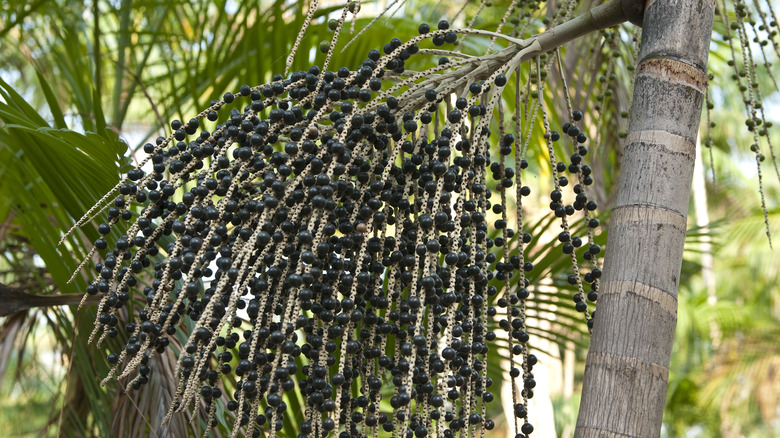
Acai is a dark purple berry that grows from a type of palm tree native to South America's Amazon rainforest, most notably in northern Brazil. The trees themselves are quite tall, making its harvest a bit of a feat. Nevertheless, as the fruit ripens and the color changes from green to dark purple, locals shimmy up the trees to slice off the goods. It has been a mainstay in the diet of Indigenous populations for hundreds of years, more recently gaining popularity in North America and around the world.
With an abundance of health claims and superfood recipes, the berries are increasingly in demand, boosting the related commercial enterprises. Unfortunately, a lot of the work falls on the shoulders of young children who have an easier time climbing the trees. Whereas traditional acai harvesting takes place in the wild or on small family farms, a growing number of plantations are popping up to support the demand.
The bulk of the harvest occurs in northern Brazil, and an estimated 70% of the product exported goes to the U.S. (via Business Insider). While the accessibility stateside is a huge benefit for anyone who wants to taste acai without trekking over to Brazil, some parts of the current system need to change to maintain the biodiversity of the region that produced the delicious berries in the first place.
Frozen pulp vs. powder vs. supplements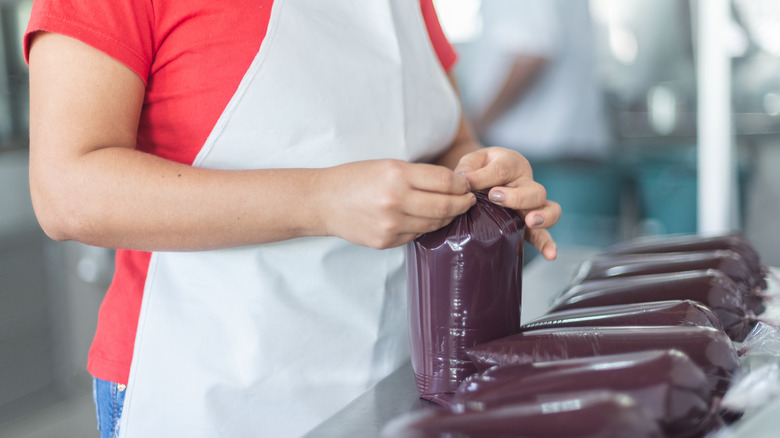
Due to its rapid perishability (we're talking as little as one day), you'll be hard-pressed to find fresh acai in the U.S. Even in its native Brazil, you're far more likely to find it as a pulp unless you're scooping it up straight after harvest. In the United States, acai powder and supplements are far more common, though you can still source frozen pulp in some locations. The format you choose will depend on what's available as well as your intended use.
For example, if you only want to consume acai for its health benefits, a supplement will suffice. These are typically produced by freeze-drying the berries to retain their nutritional qualities and then grinding them into a powder to add to a capsule. Alternatively, if you want to mix it into a shake, smoothie, or bake with it to benefit from the taste too, acai powder is a good choice. If you've tried the pulp, you'll notice that the powder tastes less intense.
The pulp offers the best of acai's sensory qualities. Apart from being stripped off the seed, pasteurized, and pureed, the pulp stays true to the fruit's natural form. It can be sweetened or blended with other ingredients to make a sorbet, smoothie, or acai bowl.
What does acai taste like?
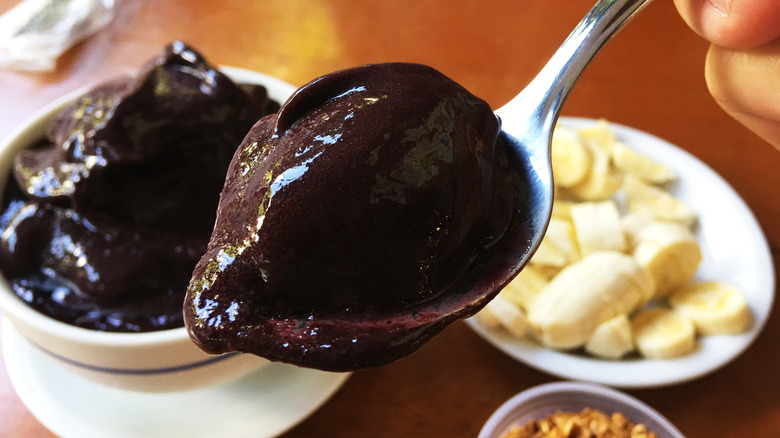
If your only experience with acai is consuming it in a smoothie bowl or sorbet, then you might think of it as notably sweet and fruity. The final flavor depends on the level and type of processing the berries undergo, but they offer more depth and nuance than you might expect. As for the texture, once the berry is pureed into a pulp, it tends to be quite smooth and velvety. However, before much processing occurs, it has more of a grainy consistency.
Being a berry, acai contains the typical balance of sweetness and tartness common to these fruits. You might taste similarities with raspberries and blackberries, with an added richness. Beyond that, it reveals complex chocolatey notes, reminiscent of dark cocoa rather than a milk chocolate bar. With this comes an element of earthiness and bitterness that is subdued if the acai pulp is blended with a sweetener, a common way to consume it stateside.
How to cook with acai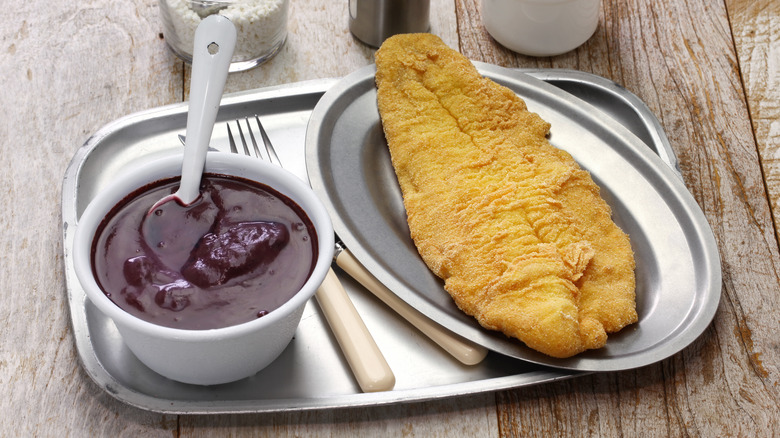
The possible uses of acai will vary whether you are starting with the powder or pulp. If you can get your hands on the latter, it offers more of the fruit's inherent qualities. Use the pulp to blend into a smoothie or smoothie bowl, incorporating other ingredients like frozen banana, milk, fresh fruit, leafy greens, or seeds as desired. Don't forget sliced banana or strawberries and granola to sprinkle over the top. If you're looking for a sweeter fix, add a liquid sweetener such as honey, maple syrup, or guarana syrup, as is typical in Brazil.
Similarly, you can add a scoop of acai powder to smoothies or bowls and benefit from the berry's taste and nutritional qualities. The powder can also be stirred into batters, such as in pancakes, waffles, or quickbreads. Transform it into syrups or add it to salad dressings for a sweet and savory twist.
Surprisingly, one of the more common ways to consume acai in its native state, Pará, is as a savory accompaniment. Left free of sweeteners or additives, you might find it served with toasted cassava flour and fried fish or dried shrimp.
Where to buy acai ?
Considering its near-immediate perishability, you won't be sourcing fresh acai berries in the U.S. anytime soon. Instead, frozen pulp, juice, or powder are more accessible products to purchase stateside. With its increased popularity, you can now buy acai from several retailers that focus on importing just the berry or a variety of tropical fruits.
Of course, Amazon comes in handy if you're looking for acai powder or supplements.
The pulp is often sold in pouches that are portioned into individual servings, either pure or pre-sweetened, or in smoothie mixes. Meanwhile, the powder is typically 100% ground acai. Depending on where you source it from, as of February 2024, the pulp will run you anywhere from $1.25 to $2.30 per serving. The powder costs a fraction of the price per serving, making it a more viable and shelf-stable option.
Nutritional and health information about acai
Acai's superfood title is a significant factor in its ever-expanding popularity. While the label is debated among certain health professionals, the consensus is that superfoods contain an especially high concentration of nutrients and have notable nutritional benefits. In the case of acai, its antioxidant content, namely anthocyanins, is of particular interest. This has led to claims of decreased risk of cancer, heart disease, and diabetes, as well as improved brain function and gut health. Granted, it's all about the context; if you're consuming acai in a sugar-laden smoothie you might be negating some of the effects.
Nutritionally, the berries are high in unsaturated fat and fiber, and low in sugar and protein (though they contain most amino acids). The vitamin and mineral concentration is pretty low, but the calcium, potassium, and iron contents are worth mentioning. The nutritional profile will vary depending on the format in which you consume acai. The freeze-drying process used to produce the powder is considered to retain more of its nutritional qualities, making it a suitable option if you want to maximize these benefits.
Varieties of acai
Although there's a low chance that you'll be shopping for different varieties of acai at your local grocery store, it's worth understanding the berry within its botanical context. There's still plenty to learn about the famous berry, but two varieties are currently identified. Most simply, they can be categorized as black or purple vs. green acai, labels that describe the color of the plant's fruit at its peak ripeness.
Black acai is more commonly grown (it's what you'll find in your frozen pulp packets and acai bowls), and increasingly cultivated as the BRS-Para Dwarf acai variety. As hinted by its name, these trees only grow a fraction of the size of acai in the wild and produce earlier ripening fruit. Meanwhile, Branco acai is harder to come by and produces green fruit in maturity. The pulp is a creamy white color, explaining the cultivar's name which translates as white acai in Portuguese.
How to store acai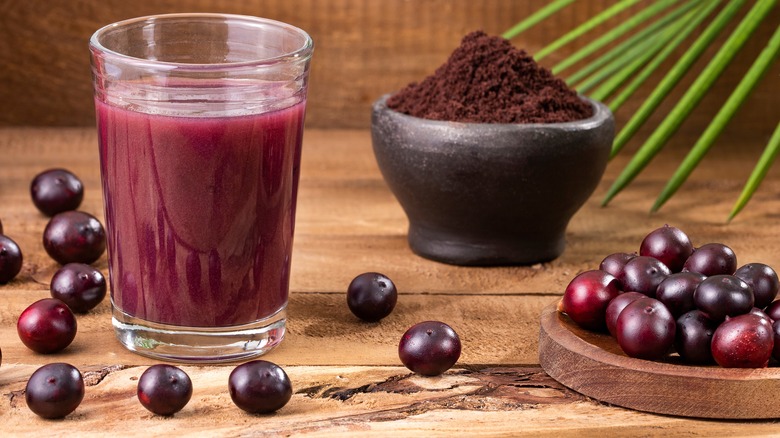
Depending on the type of acai you've purchased, be it frozen pulp, powder, supplements, or even juice, you'll want to store it appropriately to maximize its shelf life. After all, the prized fruit went on quite a trek to end up in your kitchen. Always check product labels for specific storage instructions.
If you've purchased acai in powder form, it's important to keep it in a sealed container away from direct light. Storing it in a dry cool place like your pantry will reduce the chance of moisture or heat negatively affecting the product. In these conditions, the powder could remain fresh for a couple of years.
Frozen acai pulp, on the other hand, has a shorter shelf life. It will usually indicate an expiration day of around 18 months following the processing. However, once you open the package in your freezer it's best to consume it within three months or so to guarantee peak freshness. Additionally, if it happens to defrost at some point in the interim, it should be immediately used or tossed to prevent any bacterial contamination.
https://cancersupportindia.blogspot.com. feel free to view for easy, simple and health tips
https://kneereplacement-stickclub.blogspot.com. for info on knee replacement
https://GSiyers home remedies.blogspot.com is the latest addition to my blogs.
No comments:
Post a Comment